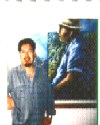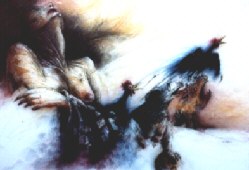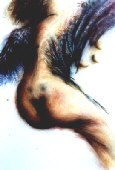Augusto |

|
|
|
|
| |

|
|
|
Voces para el Futuro, 1986 | Acuarela y Tinta, 70 x 50 cms.
| |

|
|
|
Formas en Proceso, 1987 | Acuarela y Tinta, 70 x 50 cms.
| |

|
|
|
Desde mi Jardín, 1986 | Acrilico sobre Tela, 1.10 x 0.70 mts
| |
Peterborough, Ontario Education: 1980 - University of Costa Rica, San José, Costa Rica Department of Fine Arts, Printmaking 1973 - Centre of Arts, San Salvador, El Salvador Selected Solo Exhibitions: 1994 - Imagen Galeria de Arte, Panama 1994 - The Russell Gallery of Fine Art, Lindsay, Ontario 1993 - Ironwood Gallery, Trent University, Peterborough, Ontario 1-2-3 Gallery, El Salvador 1992 - Imagen Galeria de Arte, Panama Das Giashaw, Germany 1991 - Pavillion Gallery, Hanover, Germany 1990 - 1-2-3 Gallery, El Salvador 1989 - Charlottemborg, Copenhagen, Denmark kunstforening, Roskilde, Denmark 1988 - Estudio 5, Tegucigalpa, Honduras 1987 - La Galeria, Center of Arts, El Salvador Crayon Gallery, Costa Rica imagen Galeria de Arte, Panama 1986 - Contemporanea Gallery, Costa Rica Habitante Gallery, Panama 1985 - La Galeria, Center of Arts, El Salvador 1984 - Matiz Gallery, Costa Rica 1983 - La Navas Gallery, Bogota, Columbia 1982 - El Laberinto Gallery, El Salvador Rigar Art Gallery, Miami, Florida 1981 - National Theatre, Costa Rica 1980 - La Tienda Gallery, Bremen, Germany 1977 - Charpentier Gallery, Quito, Ecuador Selected Group Exhibitions: 1994 - National Exhibition Centre, Swift Current Saskchewan 1993 - Art Gallery of Peterborough, Ontario Artcite, Windsor, Ontario 1992 - York Quay Gallery, Toronto, Ontario A Space Gallery, Toronto, Ontario 1991 - Royal Ontario Museum, Toronto, Ontario plus 50 group exhibitions from 1974-1990 in North, Central and South America, Denmark, Germany and Spain. THE RUSSELL GALLERY OF FINE ART Four Russell St., East Lindsay ONTARIO K9V 1Z6 705/878-0909 Born: El Salvador, Central America, 1956. |
In approaching Augusto Crespin's work, the critic may feel tempted to use labels like "magic realism" or "marvellous realism", concepts applied in literary criticism to the works of such Latin American writers as Miguel Angel Asturias, Alejo Carpentier and Gabriel Garcia Marquez, among others. I have chosen to set these labels aside, first, because labels tend to impoverish specific works and, second, because it is not at all certain that "magic realism" and the like are peculiar to Latin American culture. We must bear in mind however that the magical or the marvellous rises more spontaneously in art forms of cultures with deep animistic roots, whether they be African, as in the Caribbean and in Brazil or Indian as in Mexico and several countries of Central and South America. In fact, this did not escape the Surrealists and specially Andre Breton, who was fascinated by Latin American art. For the French author, indeed, "in Mexico... artistic creation is not adulterated as it is here," and this is so because, according to him, art in Mexico, Brazil and Haiti was not cut off from its roots in the world of magic (ef. Dawn Ades. Art in Latin America, Yale University Press, 1989, 216). let's say that Crespin's art is of a surrealistic and animistic nature in the sense that in his works all the worlds (the inner and the external, the mental and the physical) are in free communication and that there are no frontiers between them. It must be stressed, however, that Crespin approaches the Western imaginative pictorial tradition, mainly surrealistic, from a Latin American base. And in doing so he is reactivating one of the constants of Latin American art and literature since their very beginning, as is the case with the Mexican and Brazilian Baroque with their "primitive'~ and tellurian strength, that could surely be called Dionysian. It is obvious that many of Crespfn's works have a Latin American and even Central American touch: the brilliant colors of his palette, certain recurrent symbols regarding the encounter of the European and the Native cultures, the imagery, including tropical landscapes and most characters. Nonetheless it is also true that Crespin's art presents a marked orientation towards the human condition in general, towards life itself. That is the reason why some of his works will deploy.subjects such as the fulfilling of desire by means of the projection of fantasy or the search for new forms of life without obliterating the past. In Crespin's paintings and drawings there is still a dimension of another kind, a formal one, which appears as fragmentation of the pictorial space. It could be linked in a certain way to film aesthetics: diptychs, triptychs, superpositions. The artist is also concerned with art itself -the reason why on occasion his works become autoreflexive. In these cases in which art becomes the subject matter, the painter establishes a dialogue with pictorial tradition (with the landscape tradition, for example) or proposes a reflection on the process of artistic creation. Finally, I would like to point out the freshness and gracefulness of Crespin's art. This major aspect of his production, that we will find in one way or another in almost all of his works, appears to me as a clear manifestation of homo ludens in the realm of art. I feel, consequently, that exploring Augusto Crespin's brilliant pictorial universe may represent a fascinating aesthetical and cultural journey. Franklin B. García Sánchez Hispanic Studies Chair, Fine Arts Committee |
|